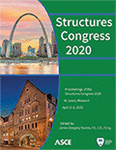Structures Congress 2020
Moving from Human Perception to Acceptability: A Paradigm Shift in Vibration Serviceability Assessment of Tall Buildings
Publication: Structures Congress 2020
ABSTRACT
The current vibration serviceability assessment (VSA) criteria for wind-induced vibrations in tall buildings is based largely on human perception threshold which is not necessarily translatable to human ‘acceptability’ of vibration. Therefore, issues such as the effects of wind-induced motions on occupants comfort, work performance, motion sickness, and sopite syndrome are not taken into account in current VSA guidelines. This paper provides an overview of the characteristics of wind-induced vibrations, state-of-the-art VSA guidelines, and the current understanding of occupants’ acceptability of wind-induced motion in tall buildings. The VSimulators facility in the Universities of Bath and Exeter to assess the effects of motion and environment on human is introduced. This facility enables in-depth research in this field through controlled simulation of structural motion and the environment and multi-modal measurement of human reactions.
Get full access to this article
View all available purchase options and get full access to this chapter.
7 Acknowledgements
This research is sponsored by EPSRC Grant No. EP/P020704/1 for Bath VSimulator project which is a part of the VSimulators facility at the Universities of Bath and Exeter.
REFERENCES
Boggs, D., 1997. Acceleration indexes for human comfort in tall buildings–Peak or RMS. CTBUH monograph.
Burton, M.D., 2006. Effects of low frequency wind-induced building motion on occupant comfort.
Caffier, P.P., Erdmann, U. Ullsperger, P., 2003. Experimental evaluation of eye-blink parameters as a drowsiness measure. European journal of applied physiology,89(3-4), pp. 319-325.
Clements-Croome, D., 2015. Creative and productive workplaces: a review. Intelligent Buildings International,7(4), pp. 164-183.
Denoon, R., 2000. Effects of wind-induced tall building motion on cognitive performance.
Denoon, R., Roberts, R., Letchford, C. Kwok, K., 2000. Field experiments to investigate occupant perception and tolerance of wind-induced building motion. RESEARCH REPORT-UNIVERSITY OF SYDNEY DEPARTMENT OF CIVIL ENGINEERING R.
Hammam, E., Hau, C.L.V., Wong, K.-S., Kwok, K. Macefield, V.G., 2014. Vestibular modulation of muscle sympathetic nerve activity by the utricle during sub-perceptual sinusoidal linear acceleration in humans. Experimental brain research, 232(4), pp. 1379-1388.
ISO 10137, 2007. Bases for design of structures–Serviceability of buildings and walkways against vibration. International Organization for Standardization Geneva.
ISO, S., 1984. Guidelines for the evaluation of the response of occupants of fixed structures, especially buildings and off-shore structures, to low-frequency horizontal motion (0.063 to 1 Hz).
Isyumov, N. Kilpatrick, J., Full-scale experience with wind-induced motions of tall buildings. In: Proceedings of 67th regional conference council on tall buildings and urban habitat, Chicago, 1996. pp. 15-18.
Jeary, A., Morris, R. Tomlinson, R., 1988. Perception of vibration—Test in a tall building. Journal of Wind Engineering and Industrial Aerodynamics,28(1-3), pp. 361-370.
Johann, F.A., Carlos, M.E. Ricardo, F.L., 2015. Wind-induced motion on tall buildings: A comfort criteria overview. Journal of Wind Engineering and Industrial Aerodynamics, 142, pp. 26-42.
Kwok, K.C., Burton, M.D. Abdelrazaq, A.K., Wind-induced motion of tall buildings: designing for habitability. In, 2015. American Society of Civil Engineers.
Kwok, K.C., Hitchcock, P.A. Burton, M.D., 2009. Perception of vibration and occupant comfort in wind-excited tall buildings. Journal of Wind Engineering and Industrial Aerodynamics,97(7-8), pp. 368-380.
Lackner, J.R., 2014. Motion sickness: more than nausea and vomiting. Experimental brain research, 232(8), pp. 2493-2510.
Lamb, S. Kwok, K.C., 2017a. The fundamental human response to wind-induced building motion. Journal of Wind Engineering and Industrial Aerodynamics, 165, pp. 79-85.
Lamb, S. Kwok, K.C., 2017b. Sopite syndrome in wind-excited buildings: productivity and wellbeing impacts. Building Research Information, 45(3), pp. 347-358.
Lamb, S., Kwok, K.C. Walton, D., 2013a. Occupant comfort in wind-excited tall buildings: motion sickness, compensatory behaviours and complaint. Journal of Wind Engineering and Industrial Aerodynamics, 119, pp. 1-12.
Lamb, S., Kwok, K.C. Walton, D., The occupant response to wind-induced tall building motion in New Zealand. In: Proceedings of the 6th European-African Conference on Wind Engineering (EACWE), July 7-11, 2013, Cambridge, UK, 2013b.
Lamb, S., Kwok, K.C. Walton, D., 2014. A longitudinal field study of the effects of wind-induced building motion on occupant wellbeing and work performance. Journal of wind engineering and industrial aerodynamics, 133, pp. 39-51.
Lamb, S., Macefield, V.G., Walton, D. Kwok, K.C., 2016. Occupant response to wind-excited buildings: a multidisciplinary perspective. Proceedings of the Institution of Civil Engineers-Structures and Buildings, 169(8), pp. 625-634.
Lawson, B. Mead, A., 1998. The sopite syndrome revisited: drowsiness and mood changes during real or apparent motion. Acta astronautica, 43(3-6), pp. 181-192.
Matsangas, P. McCauley, M.E., 2014. Sopite syndrome: a revised definition. Aviation, space, and environmental medicine, 85(6), pp. 672-673.
Mendis, P., Ngo, T., Haritos, N., Hira, A., Samali, B. Cheung, J., 2007. Wind loading on tall buildings. Electronic Journal of Structural Engineering.
Peirce, J., Gray, J.R., Simpson, S., MacAskill, M., Höchenberger, R., Sogo, H., Kastman, E. Lindeløv, J.K., 2019. PsychoPy2: Experiments in behavior made easy. Behavior research methods, 51(1), pp. 195-203.
Information & Authors
Information
Published In
ISBN (Online): 978-0-7844-8289-6
Copyright
© 2020 American Society of Civil Engineers.
History
Published online: Apr 2, 2020
Published in print: Apr 2, 2020
Authors
Metrics & Citations
Metrics
Citations
Download citation
If you have the appropriate software installed, you can download article citation data to the citation manager of your choice. Simply select your manager software from the list below and click Download.
